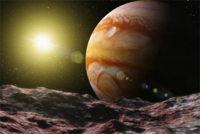Jupiter Moons

Jupiter is the largest planet in the solar system. The outermost atmosphere of Jupiter is visibly segregated into several bands at different latitudes, which results in turbulence and storms. A prominent result is the Great Red Spot, a giant storm that is believed to have been existed since 17th century when it was first seen by telescope. Surrounding Jupiter is a powerful magnetosphere and a faint planetary ring system. Including the four large Galilean moons, Jupiter has at least 69 moons. The Galilean moons were discovered by Galileo Galilei in 1610. Ganymede which is the largest of these, has a greater diameter than that of the planet Mercury.
Jupiter is the fifth planet from the Sun. It is considered as a giant planet which is two-and-a-half times that of all the other planets in the Solar System combined. Jupiter and Saturn are called as gas giants. The other two giant planets are Uranus and Neptune which are known as ice giants. Since ancient times, Jupiter has been known to astronomers. The Romans named it after their god Jupiter. Jupiter can reach an apparent magnitude of -2.94, bright enough for its reflected light to cast shadows when viewed from the Earth. On an average it is considered as the third-brightest object in the night sky after the Moon and Venus.
Jupiter is composed of hydrogen with a quarter of its mass of helium, though helium comprises only about a tenth of the number of molecules. Jupiter lacks a well-defined solid surface unlike the other giant planets. The planet’s shape is of an oblate spheroid (it has a slight but noticeable bulge around the equator) because of its rapid rotation. Jupiter has been examined on several occasions by robotic spacecraft, especially during the early Pioneer and Voyager flyby missions and later by the Galileo orbiter. In late February 2007, Jupiter was visited by the New Horizons probe, which used Jupiter’s gravity to increase the speed and bend its trajectory en route to Pluto. The latest probe to visit the planet is Juno, which entered into orbit around Jupiter on July 4, 2016.
Physical Characteristics Of Jupiter
Jupiter is the largest of the four giant planets in the Solar System which is composed of gaseous and liquid matter. At its equator,it has a diameter of 142,984 km (88,846 mi). It is the second highest of the giant planets with an average density of 1.326 g/cm3 but lower than those of the four terrestrial planets.

Compostion
Jupiter’s upper atmosphere is about 88–92% of hydrogen and 8–12% of helium by percent volume of gas molecules. Thus, Jupiter’s atmosphere is approximately about 75% of hydrogen and 24% of helium by mass, with remaining 1% of the mass containing other elements. The atmosphere which contains trace amounts of methane, water vapor, ammonia, and silicon-based compounds also contains traces of carbon, ethane, hydrogen sulfide, neon, oxygen, phosphine, and sulfur. The outermost layer of the atmosphere contains crystals of frozen ammonia. The innermost layer contains denser materials by mass which is roughly 71% hydrogen, 24% helium, and 5% other elements. Trace amounts of benzene and other hydrocarbons have been found through infrared and ultraviolet measurements. Neon in the upper most atmosphere which contains 20 parts per million by mass.To the theoretical composition of the primordial solar nebula, the atmospheric proportions of hydrogen and helium are relatively close.
Solar System | Mercury | Venus Moons | Earth | Mars Moons | Jupiter Moons | Saturn Moons | Uranus Moons | Neptune Moons | International Space System | ISS Research | Moons of the planet | Magnetosphere | Regions Of Comets | Space Station Glossary | Space Station Abbreviation | Space Station Sitemap | Asteriods | Contact Us